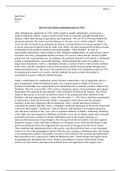Raul 1
Raul Patel
History
Y13
How far was Stalin a totalitarian ruler by 1941?
After defeating his opposition in 1928, Stalin sought to rapidly industrialise, and become a
modern industrial country; a nation which would create its economic strength through heavy
industry, rather than relying on agriculture (pre-industrial). “We are 50 to 100 years behind the
advanced countries. We must cover the distance in 10 years, or we will be crushed”. Stalin’s
view was that of a need for an industrial revolution, to ensure Russia was strong enough to stay
in power and protect himself from his main rival; Hitler, who had expressed his feelings towards
communism in his political manifesto and autobiography; “Mein Kampf”. In order to
successfully industrialise, Stalin needed to fully integrate totalitarianism; he required the control
of politics, the army, propaganda and the economy, in a society where and all control of public
and private life is government run. According to the political scientist Carl Fredrich, a totalitarian
regime is distinguished by a powerful ideology; which promised the onset of a golden era, a
single mass-based party; led by a charismatic dictator, a system of terror; built around a ruthless
police force, and the centralised control of the economy and the Russian people through mass
media and armed forces. This essay will evaluate how far Stalin was a totalitarian ruler by 1941
by analysing his control over society, and the methods he used to control the people to
consolidate his power within the Bolshevik party.
Stalin’s enforcement of a totalitarian society became evident after a rise of opposition. Kirov’s
gain in popularity within the Bolshevik party was a serious threat to Stalin, as he knew his
position in leadership was compromised as he found himself in a minority position within in the
Politburo. This was seen in May 1934, as Kirov proposed a policy of reconciliation, and argued
that people who opposed the government’s ideas should be freed from all charges. This forced
Stalin to take action as he knew he had lost control of his protégé and other members of the
Politburo who had supported Kirov’s ideas. On December 1st, 1934, Kirov had been assassinated,
to what today is believed to be under Stalin’s commands, which shows how his strongest
members of the party disagreed with his leadership. Kirov’s death had allowed Stalin to
commence the purges and show trials; a campaign of political repression in the Soviet Union and
a series of trials against “Trotskyists” such as Zinoviev and Kamenev; two natural successors
who had been executed as they were seen as potential liabilities to Stalin’s leadership. Members
of the right were also targeted, as Bukharin and Rykov were sent to labour camps and eventually
executed to prevent a counter revolution. Rebellions such as the August Uprising, an
unsuccessful insurrection in an attempt to free Georgia from Soviet control, were also targeted
during the purges, as they had major influences in Georgian towns; which forced Stalin to take
action and eliminate those who supported the succession of Georgia from the Soviet Union.
These methods had implemented fear in the society, and allowed him to have a more dominant
control over the wide geographical spread of Russia, thus creating a totalitarian state. The feeling
of an omnipresent control of the people was due to local officials who executed and imprisoned
their personal rivals to gain power within the Bolshevik party, which became the biggest factor
in spreading fear throughout the towns. Stalin’s consolidation of power allowed him to take
control over the citizens, and ensure his political rivals and opponents of his regime were





